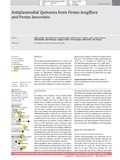Antiplasmodial Quinonesfrom Pentaslongiflora and Pentas lanceolata

View/
Date
2012-01Author
Milkyas Endale.
Alao John Patrick.
Akala Hoseah M.
Rono Nelson K.
Eyase Fredrick L.
Derese Solomon.
Ndakala Albert.
Mbugua Martin Njogu.
Sunnerhagen Per.
Erdelyi Mate.
Yenesew Abiy.
Type
ArticleLanguage
enMetadata
Show full item recordAbstract
The dichloromethane/methanol (1:1) extracts of
the roots of Pentas longiflora and Pentas lanceolata
showed low micromolar (IC50=0.9–3µg/mL) in
vitro antiplasmodial activity against chloroquineresistant
(W2) and chloroquine-sensitive (D6)
strains of Plasmodium falciparum. Chromatographic
separation of the extract of Pentas longiflora
led to the isolation of the pyranonaphthoquinones
pentalongin (1) and psychorubrin (2)
with IC50 values below 1µg/mL and the naphthalene
derivative mollugin (3), which showed marginal
activity. Similar treatment of Pentas lanceolata
led to the isolation of eight anthraquinones
(4–11,IC50=5–31µg/mL) of which one is new
(5,6-dihydroxydamnacanthol, 11), while three–
nordamnacanthal (7), lucidin-ω-methyl ether (9),
and damnacanthol (10)– are reported here for
the first time from the genus Pentas. The compounds
were identified by NMR and mass spectroscopic
techniques.
Supportinginformation available online at
http://www.thieme-connect.de/ejournals/toc/
plantamedic
URI
http://erepository.uonbi.ac.ke:8080/xmlui/handle/123456789/9861http://www.ncbi.nlm.nih.gov/pubmed/21979929
Citation
Planta Med. 2012 Jan;78(1):31-5.Publisher
Chemistry
Subject
Pentas longifloraPentas lanceolata
Pentas longiflora
Rubiaceae
anthraquinone
5,6‑dihydroxydamnacanthol‑pyranonaphthoquinone
malaria
